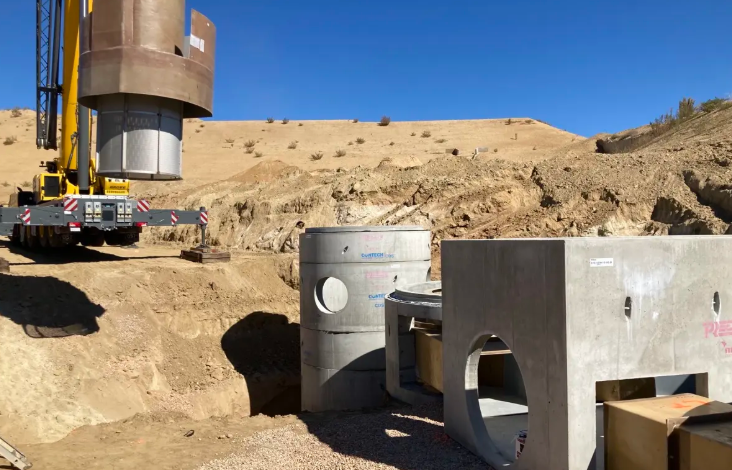Scaling Hydrodynamic Separator Systems: How Precast Concrete Solves Large-Scale Challenges

Managing stormwater is more critical than ever as cities grow and heavy rainfall becomes more common. To protect our waterways and prevent flooding, we need intelligent systems that filter out harmful debris, oil, and pollutants before water enters storm drains or nearby rivers. This is especially true for large projects like highways, industrial areas, and airports, where stormwater runoff can be intense and frequent.
That’s where hydrodynamic separators come in. These systems help clean stormwater by spinning it through chambers that separate unwanted materials. However, making these systems work on a larger scale presents challenges, particularly when strength, space, and speed are critical. Precast concrete has become a reliable solution for scaling these systems, offering both durability and easier installation.
In this blog, we will explore hydrodynamic separators, how they work, and the challenges and solutions of scaling them using precast concrete.
What Are Hydrodynamic Separators?
Hydrodynamic separators are systems that treat stormwater. They remove harmful substances like sediment, oil, and trash from the runoff. They use swirling or circular water flow to separate and capture debris before it enters storm drains or nearby water bodies. Compact and low-maintenance, these systems are commonly used in urban areas, parking lots, roads, and other developed sites to help improve water quality and prevent pollution.
How Do Hydrodynamic Separators Work?
Hydrodynamic separators clean stormwater by using innovative designs and natural forces like gravity and circular water flow. Here’s how the process works:
- Inlet Flow Control
When stormwater enters the system, it passes through an inlet that helps slow down the flow and guide it into the main chamber. This step controls the speed and prevents too much splashing or turbulence.
- Centrifugal Force
As the water enters the chamber, it begins to spin in a circular motion. This spinning movement pushes heavier materials like sand, dirt, and debris toward the outer edge of the chamber and then down to the bottom.
- Pollutant Removal
While the heavier particles settle at the bottom, oils and floating trash rise to the top. Cleaner water flows out through the outlet pipe, leaving behind the unwanted materials.
- Maintenance
Over time, the collected sediment and debris must be removed. Crews usually clean the system using vacuum trucks to keep it working correctly and protect nearby water sources.
See also: The Strategic Importance of 4805306022 in Global Tech Development
Challenges of Scaling Precast Concrete in HDS Systems & Their Solutions
As hydrodynamic separator (HDS) systems grow to support large infrastructure projects, using precast concrete offers unique benefits but also brings specific challenges. These issues often become more pronounced as the size and complexity of the project increase. Here are precast concrete challenges & their solutions.
- Increased Weight and Handling Difficulties
Precast concrete is strong and durable, but it’s also heavy. As HDS systems get larger, so do the individual components. This added weight can make lifting, maneuvering, and placing the units more difficult during installation. It also requires special equipment and a well-trained crew to be managed safely and efficiently.
To address this problem, many projects now use modular precast units instead of large, single-piece structures. These smaller sections are more manageable to transport and install without sacrificing performance. Planning lifting points and delivery access also helps reduce risks and delays on-site.
- Increased Structural Load Requirements
When scaling up, HDS systems often need to be installed under roadways, loading docks, or industrial sites where they must support heavy traffic or equipment. Larger systems must be engineered to handle these higher loads without cracking or failing over time.
To solve this hurdle, precast units are reinforced to meet higher structural standards, including traffic-rated designs that meet or transcend local regulations. Using certified engineering practices during design ensures the final system is strong enough to perform safely under all expected conditions.
- Transportation and Crane Limitations
Transporting significant precast components can be logistically complex. Wide loads may require special permits or escorts, and heavy components need specific crane capacities and setup areas. If not planned properly, this can lead to unexpected costs or delays.
To address this challenge, manufacturers often design precast components with shipping and lifting in mind. Coordinating delivery schedules with crane availability and stage zones is critical. Breaking the system into effortless segments allows for standard transportation methods and reduces the need for large equipment.
- Limited Site Space for Large Installations
Many large-scale HDS installations take place in busy, space-constrained environments. Whether it’s a tight urban lot or a site with limited recess access, working in close quarters can make it difficult to place and connect large concrete structures.
To solve this hurdle, use short, buried options or tightly made precast pieces. They fit where there is not much room. Modular systems allow components to be installed in stages, minimizing the space required at any given time. Good site planning also ensures all equipment and materials are organized for efficiency and safety.
- Coordination with Other Utilities in Large Projects
Large infrastructure projects often involve multiple underground utilities like sewer lines, electrical conduits, and water mains. Precast HDS systems must be carefully placed to avoid conflicts with these existing or planned services.
To address this challenge, design teams use digital tools like 3D modeling and BIM to map utilities and plan around them. Precast manufacturers can provide custom openings and pipe connections based on accurate field data. Early collaboration between all engineering disciplines helps prevent costly rework during construction.
- On-Site Assembly & Installation Time
Even with prefabricated components, assembling a large-scale HDS system on-site can take time. Misalignments, difficult site conditions, or poor coordination can stretch out timelines and create downstream delays for the project.
To solve this hurdle, contractors use detailed installation drawings and pre-approved lifting plans to streamline the process. Precast units are manufactured with patience to ensure clean connections, and joint sealing systems are pre-installed or easy to apply. Keeping the process efficient means fewer people on-site, reduced disruption, and faster project turnover.
- Customization for Unique Site Conditions
No two project sites are the same. Differences in grade, soil conditions, and pipe elevations can create complications for standard precast designs. Scaling HDS systems sometimes means working with a patchwork of constraints that must be solved before installation begins.
To address this challenge, manufacturers offer custom precast options tailored to the project’s unique requirements. Flexible inlet and outlet configurations, custom riser heights, and adjustable fittings allow designers to adapt without sacrificing system performance. Starting the customization process early in the design phase ensures smooth execution later on.
- Long-Term Maintenance at Scale
As HDS systems scale up, so does the effort required to keep them clean and functioning. Accessing deeper or multi-chamber systems for vacuum cleaning or inspection can be more time-consuming and may require special equipment if not correctly planned.
To address this challenge, systems are designed with multiple access points, large cleanout openings, and internal layouts that make it easier for maintenance teams to reach sediment traps and debris zones. Some systems now include remote monitoring tools to alert managers when cleaning is needed, reducing guesswork and improving overall performance.
Final Thoughts
Scaling hydrodynamic separator systems to meet the demands of growing urban environments can be complex, but precast concrete offers a practical and robust solution. Its strength, flexibility, and efficiency make it ideal for handling larger volumes, tighter spaces, and long-term performance needs. By addressing common challenges like heavy components, limited space, and installation constraints with innovative design and planning, precast systems become not only scalable but also sustainable. With the right approach, precast concrete ensures that large-scale stormwater management remains reliable, cost-effective, and durable.






